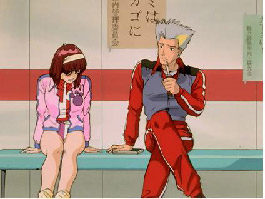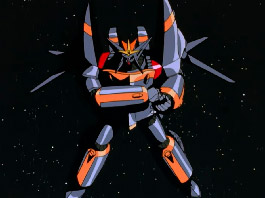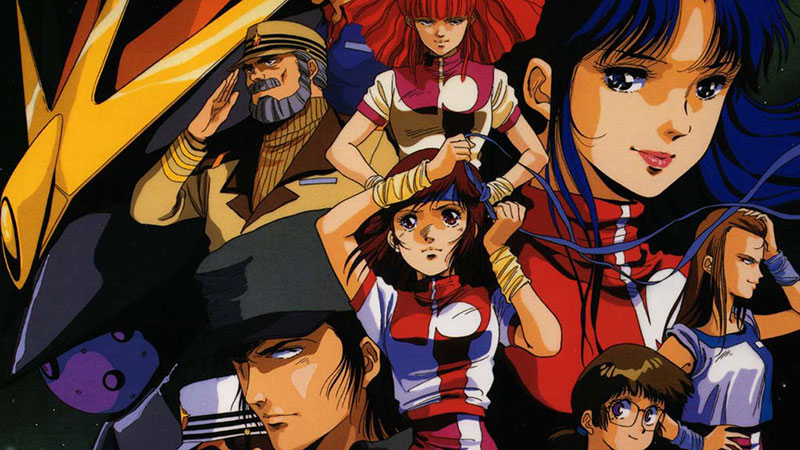I want to preface this with a little Pink Floyd lyric… “Remember when you were young. You shown like the sun. Shine on You Crazy Diamond.” I can take this a couple ways in regards to Gunbuster. First it is a love letter homage to an era of anime and special effects shows from the 1960s to about 1980. This is Studio Gainax remembering the beauty of discovering such fantastic visual fun in their youth. But, I have to point out our main heroine, Noriko Takaya, as the second reason. In this six episode OVA everything and everybody to some certain extent got older and or eventually left the material plane of her existence. All except Noriko, who because of traveling so much in sub-space remains forever young and in the process missed out on being with most of her peers. How many times have you felt that no matter what you did, you could not share it with certain individuals you truly loved?
want to preface this with a little Pink Floyd lyric… “Remember when you were young. You shown like the sun. Shine on You Crazy Diamond.” I can take this a couple ways in regards to Gunbuster. First it is a love letter homage to an era of anime and special effects shows from the 1960s to about 1980. This is Studio Gainax remembering the beauty of discovering such fantastic visual fun in their youth. But, I have to point out our main heroine, Noriko Takaya, as the second reason. In this six episode OVA everything and everybody to some certain extent got older and or eventually left the material plane of her existence. All except Noriko, who because of traveling so much in sub-space remains forever young and in the process missed out on being with most of her peers. How many times have you felt that no matter what you did, you could not share it with certain individuals you truly loved?
 Gunbuster begins amid much promise and joy as sixteen year old Noriko Takaya is a new student at an Okinawa high school that specializes in training space pilots. She hopes to someday be like her father (an admiral who died while serving in space), like her idol the beautiful and talented Kazumi Amano and prove herself able to the Coach Ohta (COACHEE!). Right from the word go we are essentially brought into a shojo sports anime that passes itself as a sci-fi mecha series (Aim for the Ace+Yamato+Getter Robo+Top Gun (wait that’s a Hollywood film)=GUNBUSTAA!!). Who knew one had to train in robots and run laps, do sit-ups and various other forms of exercise. I thought our heroes just climbed into mecha and magically knew how to pilot them from instinct?
Gunbuster begins amid much promise and joy as sixteen year old Noriko Takaya is a new student at an Okinawa high school that specializes in training space pilots. She hopes to someday be like her father (an admiral who died while serving in space), like her idol the beautiful and talented Kazumi Amano and prove herself able to the Coach Ohta (COACHEE!). Right from the word go we are essentially brought into a shojo sports anime that passes itself as a sci-fi mecha series (Aim for the Ace+Yamato+Getter Robo+Top Gun (wait that’s a Hollywood film)=GUNBUSTAA!!). Who knew one had to train in robots and run laps, do sit-ups and various other forms of exercise. I thought our heroes just climbed into mecha and magically knew how to pilot them from instinct?
 As stated earlier this is a love letter, the real definition of “Fan Service.” Aside from a couple shots of the usual “Fan Service” this show drips references of the many series I listed earlier and more as cues to say this show is for you or us. You loved this show, this type of character, this scene, etc.? Gainax is a studio founded by fans after all and this is them paying homage to the highest degree. It’s anime about anime. And what makes Gunbuster special is the fact that yes, there are a lot of these references, but it also tugs at you over time. Similar to Evangelion or Nadia (both directed by Hideaki Anno) we start off in fun and games and eventually step into the darker side. But Gunbuster is not so much grim as it is poignant. Young Noriko grows up learning about falling in love, reconnecting with the her lost past and maturity in general. It has a sweetness that is missing from Evangelion or Nadia. And it is this tenderness that makes it hold up still today. Plus, the artwork and animation is gorgeous and handled with the greatest of care. Even the last episode fades to that old standard of black and white. The first time I saw it I thought something was wrong with my TV.
As stated earlier this is a love letter, the real definition of “Fan Service.” Aside from a couple shots of the usual “Fan Service” this show drips references of the many series I listed earlier and more as cues to say this show is for you or us. You loved this show, this type of character, this scene, etc.? Gainax is a studio founded by fans after all and this is them paying homage to the highest degree. It’s anime about anime. And what makes Gunbuster special is the fact that yes, there are a lot of these references, but it also tugs at you over time. Similar to Evangelion or Nadia (both directed by Hideaki Anno) we start off in fun and games and eventually step into the darker side. But Gunbuster is not so much grim as it is poignant. Young Noriko grows up learning about falling in love, reconnecting with the her lost past and maturity in general. It has a sweetness that is missing from Evangelion or Nadia. And it is this tenderness that makes it hold up still today. Plus, the artwork and animation is gorgeous and handled with the greatest of care. Even the last episode fades to that old standard of black and white. The first time I saw it I thought something was wrong with my TV.
Now Studio Gainax aside, if there is one individual who makes this OVA very special for me, it would have to be the great Haruhiko Mikimoto. I love this man’s work (I DO!, I DO!, I DO!) and for me, nothing and I mean nothing tops his character designs. The elegance and grace that is apart of his early signature style shows true form here and I rank the designs as great as the work he did for the original Macross and Orguss. “I wish they all could be Mikimoto girls” (to the tune of Beach Boys’ California Girls). There is always a certain twinkle in the eye of those who are conceptualized by my man, right?
 Gunbuster may have been the second official project of Studio Gainax, and the directorial debut of Mr. Anno, but it would set a precedent that would follow for this group into the 1990s. It also reflects back to those of us who were excited about the future and the possibility of traveling through outer space like it was driving down the highway and piloting large mecha… but alas all we have are smart phones and wifi, kind of a let down when you compare it to our utopian vision of the future. Still there is a possibility if we all believe it is possible and stay young in heart and mind. Let’s raise a toast to you Gunbuster… we love you. KANPAI!!!
Gunbuster may have been the second official project of Studio Gainax, and the directorial debut of Mr. Anno, but it would set a precedent that would follow for this group into the 1990s. It also reflects back to those of us who were excited about the future and the possibility of traveling through outer space like it was driving down the highway and piloting large mecha… but alas all we have are smart phones and wifi, kind of a let down when you compare it to our utopian vision of the future. Still there is a possibility if we all believe it is possible and stay young in heart and mind. Let’s raise a toast to you Gunbuster… we love you. KANPAI!!!



 Megazone 23 could be my favorite one off OVA of all time. True there are two other parts, well three since part three is a two-parter. Megazone 23, the first one, the original, is in my mind enough
Megazone 23 could be my favorite one off OVA of all time. True there are two other parts, well three since part three is a two-parter. Megazone 23, the first one, the original, is in my mind enough  Megazone 23 is far from the first anime I was exposed to, but I can say for sure it was the first that solidified me as an otaku. Before Megazone 23 I had a good working knowledge of well known titles at the time and that I was aware of: Robotech, Gundam Wing, Akira, Ghost in the Shell, Record of Lodoss War… you get the picture. Mostly well known popular stuff, quasi-casual may be a better term. I needed to locate more niche material. So I landed on Megazone 23 and Area 88, not a bad combination if I say so.
Megazone 23 is far from the first anime I was exposed to, but I can say for sure it was the first that solidified me as an otaku. Before Megazone 23 I had a good working knowledge of well known titles at the time and that I was aware of: Robotech, Gundam Wing, Akira, Ghost in the Shell, Record of Lodoss War… you get the picture. Mostly well known popular stuff, quasi-casual may be a better term. I needed to locate more niche material. So I landed on Megazone 23 and Area 88, not a bad combination if I say so. Begun as a so called follow-up to a show most Robotech fans should be familiar with, Genesis Climber Mospeada, Megazone 23 had an interesting start. I often consider this show to be the true sequel to Macross (another nod to Robotech), if not in name, as it shares a majority of it’s key staff including director Noboru Ishiguro and character designers Toshihiro/Toshiki Hirano and Haruhiko Mikimoto (three men I have the highest of respect for). I won’t get into the historic details too much, but the production started off as a TV series with various working titles until the main sponsor pulled the plug. No money, big problem, what to do? Release it direct to video since that is a growing market and thankfully, that is what happened. Who knows how much of the plot was cut to fit it into an approximate 80 minute running time? But in the end who cares, it worked.
Begun as a so called follow-up to a show most Robotech fans should be familiar with, Genesis Climber Mospeada, Megazone 23 had an interesting start. I often consider this show to be the true sequel to Macross (another nod to Robotech), if not in name, as it shares a majority of it’s key staff including director Noboru Ishiguro and character designers Toshihiro/Toshiki Hirano and Haruhiko Mikimoto (three men I have the highest of respect for). I won’t get into the historic details too much, but the production started off as a TV series with various working titles until the main sponsor pulled the plug. No money, big problem, what to do? Release it direct to video since that is a growing market and thankfully, that is what happened. Who knows how much of the plot was cut to fit it into an approximate 80 minute running time? But in the end who cares, it worked. Being the fact that this production was released direct to video, it gave those who grew up with mecha as their preferred genre an even more “realistic” grown up story following the growing sophistication of epics like Gundam, Macross and Votoms. Of course the growing popularity of the fighting genre (Fist of the North Star, Dragon Ball and Saint Seiya) signaled an end to the television dominance of mecha. Zeta Gundam, also a 1985 release, is in my mind the capstone to an era in television where mecha grew in sophistication and serious subject matter that did not come back again until possibly Evangelion. Many of those who grew up in the 70s/early 80s now needed a new avenue to find material and in many cases material to match their growing maturity. Megazone 23 was in the perfect place at the perfect time.
Being the fact that this production was released direct to video, it gave those who grew up with mecha as their preferred genre an even more “realistic” grown up story following the growing sophistication of epics like Gundam, Macross and Votoms. Of course the growing popularity of the fighting genre (Fist of the North Star, Dragon Ball and Saint Seiya) signaled an end to the television dominance of mecha. Zeta Gundam, also a 1985 release, is in my mind the capstone to an era in television where mecha grew in sophistication and serious subject matter that did not come back again until possibly Evangelion. Many of those who grew up in the 70s/early 80s now needed a new avenue to find material and in many cases material to match their growing maturity. Megazone 23 was in the perfect place at the perfect time.
You must be logged in to post a comment.